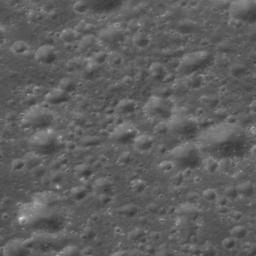
|
Cluster of Farside Secondary Craters
- Click the image above for a larger view
- Full-Res JPEG (1000 x 1000) (77.3 kB)
- Full-Res TIFF (1000 x 1000) (1.0 MB)
Caption:
Cluster of secondary craters help geologists determine the relative ages of features, even when they are separated by great distances. Image width is 630 meters.
When people envision a "moonscape" it probably looks something like this -- craters, craters everywhere. There are two types of impact craters on the Moon: primary and secondary. Primary craters form as the result of an asteroid or comet (or spacecraft) impacting the Moon. Secondary impact craters formed from the impact of ejecta expelled during primary crater formation. Secondary impact craters dominate this scene, possibly from the impact event that created nearby Jackson crater (70 km diameter), a fresh crater located 68 km to the west.
Background Info:
NASA's Goddard Space Flight Center built and manages the mission for the Exploration Systems Mission Directorate at NASA Headquarters in Washington. The Lunar Reconnaissance Orbiter Camera was designed to acquire data for landing site certification and to conduct polar illumination studies and global mapping. Operated by Arizona State University, the LROC facility is part of the School of Earth and Space Exploration (SESE). LROC consists of a pair of narrow-angle cameras (NAC) and a single wide-angle camera (WAC). The mission is expected to return over 70 terabytes of image data.
Cataloging Keywords:
| Name | Value | Additional Values |
|---|---|---|
| Target | Moon | |
| System | Earth | |
| Target Type | Satellite | |
| Mission | Lunar Reconnaissance Orbiter (LRO) | |
| Instrument Host | Lunar Reconnaissance Orbiter | |
| Host Type | Orbiter | |
| Instrument | Lunar Reconnaissance Orbiter Camera (NAC) | |
| Detector | Narrow Angle Camera (NAC), Wide Angle Camera (WAC) | |
| Extra Keywords | Asteroid, Comet, Crater, Grayscale, Impact | |
| Acquisition Date | ||
| Release Date | 2009-11-23 | |
| Date in Caption | ||
| Image Credit | NASA/GSFC/Arizona State University | |
| Source | photojournal.jpl.nasa.gov/catalog/PIA12929 | |
| Identifier | PIA12929 | |
